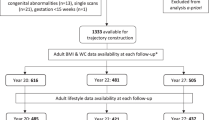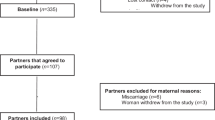Abstract
Birth size and shape are commonly used as indicators of fetal growth. Epidemiologic studies have suggested a relationship between birth size and the risk of developing cardiovascular disease in later life. Certain “growth phenotypes” have been linked to the development of certain components of cardiovascular disease, particularly babies who display disproportional growth in utero. These observations are based on retrospective analysis of historical data sets. If the “Fetal Origins of Adult Disease” hypothesis is to be generalisable to the present day, then it is essential to establish whether these “growth phenotypes” exist within the normal distribution of birth size. The UCL Fetal Growth Study is a prospective study of antenatal fetal growth assessed by ultrasound at 20 and 30 wk gestation in 1650 low risk, singleton, white pregnancies. Measures of birth size were obtained and analyzed by principal components to explain shape at birth. Birth measures were also related to antenatal growth measurements to determine the strength of ultrasound evaluation in determining subsequent growth.
There was significant sexual dimorphism in all measures at birth, with males heavier, longer, and leaner than females. From 20 wk of gestation onwards, males had a significantly larger head size than females. Parity, maternal height, and body mass index were important determinants of birth weight (p < 0.001). Cigarette smoking influenced birth weight, length, and head circumference (p < 0.001) but had no effect on placental size. Principal component analysis revealed that proportionality was the predominant size/shape at birth (55% of variance explained). A further 18% of variance was explained by a contrast between weight, head circumference, and length versus three skinfolds. Anthropometric measures as assessed by ultrasound at 20 and 30 wk gestation were poor predictors of birth length, weight, and head circumference (adjusted R2 18, 40, and 28% at 30 wk gestation scan, respectively). These predictions were not improved by including growth patterns between 20 and 30 wk. There is sexual dimorphism in a number of anthropometric measures at birth and in utero. These sex differences are important determinants of body size and shape. In a low risk population delivering at term, body shape was largely determined by proportionality between anthropometric measures. The low correlations between antenatal measures and birth size suggest that it is unwise to ascribe birth shape phenotypes to adverse events at any particular stage of gestation. The weak relationship also suggests that routine antenatal scans around 30 wk of gestation to predict growth problems are unlikely to be of benefit in the majority of cases.
Similar content being viewed by others
Log in or create a free account to read this content
Gain free access to this article, as well as selected content from this journal and more on nature.com
or
Abbreviations
- ANOVA:
-
Analysis of variance
- BMI:
-
Body mass index
- SDS:
-
SD score
References
Frankel S, Elwood P, Sweetnam P, Yarnell J, Davey Smith G 1996 Birthwight, body mass index in middle age incident coronary heart disease. Lancet 348: 1478–1480
Smith GCS, Smith MFS, McNay MB, Fleming JEE 1998 First-trimester growth the risk of low birth weight. N Engl J Med 339: 1817–1822
Tanner JM 1989 Foetus into Man, 2nd Ed. Castlemead Publications, Ware, Herts
Urrusti J, Yoshida P, Velasco L, Frenk S, Rosado A, Sosa A, Morales M, Yoshida T, Metcoff J 1972 Human fetal growth retardation. I. Clinical features of samples with intrauterine growth retardation. Pediatrics 50: 547–558
Villar J, Belizan JM 1982 The timing factor in the pathophysiology of the intrauterine growth retardation syndrome. Obstet Gynecol Surv 37: 499–506
Kramer MS, Olivier M, McLean FH, Willis DM, Usher RH 1990 Impact of intrauterine growth retardation body proportionality on fetal neonatal outcome. Pediatrics 86: 707–713
Kingdom JCP, Smith G 2000 Diagnosis and management of IUGR. In: Kingdom JCP and Baker P (eds) Intrauterine Growth Restriction-Aetiology and Management. Springer, London, 257–270
Bricker L, Neilson JP 2000 Routine ultrasound in late pregnancy (after 24 weeks gestation). Cochrane Review. In: The Cochrane Library, Issue 1. Update Software, Oxford
Ravelli AC, van der Meulen JH, Michels RP, Osmond C, Barker DJ, Hales CN, Bleker OP 1998 Glucose tolerance in adults after prenatal exposure to famine. Lancet 351: 173–177
Barker DJP, Gluckman PD, Godfrey KM, Harding JE, Owens JA, Robinson JS 1993 Fetal nutrition cardiovascular disease in adult life. Lancet 341: 938–941
Barker DJP, Hales CN, Fall CHD, Osmond C, Phipps K, Clark PMS 1993 Type 2 (non-insulin dependent) diabetes mellitus, hypertension hyperlipidaemia (Syndrome X): relation to reduced fetal growth. Diabetologia 36: 62–67
Seeds JW 1984 Impaired fetal growth. Obstet Gynecol 64: 577–584
Neilson JP, Munjanja SP, Whitfield CR 1984 Screening for small for dates fetuses: a controlled trial. BMJ 289: 1179–1182
Office of Federal Statistical Policy and Standards 1991 Standard Occupational Classification, 3. U.S. Government Printing Office, Washington DC
Freeman JV, Cole TJ, Chinn S, Jones PRM, White EM, Preece MA 1995 Cross-sectional stature weight reference curves for the UK, 1990. Arch Dis Child 73: 17–24
Armitage P, Berry G 1994 Statistical Methods in Medical Research, 3rd Ed. Blackwell Science, Oxford
Gruenwald P 1978 Intrauterine growth. In: Stuve U (ed) Perinatal Physiology. Plenum, New York, 1–18
Butler NR, Goldstein H, Ross EM 1972 Cigarette smoking in pregnancy: its influence on birth weight perinatal mortality. BMJ 2: 127–130
Williams LA, Evans SF, Newnham JP 1997 Prospective cohort study of factors influencing the relative weights of the placenta newborn infant. BMJ 314: 1864–1868
Howe DT, Wheeler T, Osmond C 1995 The influence of maternal haemoglobin ferritin on mid-pregnancy placental volume. Br J Obstet Gynaecol 102: 213–219
De Zegher F, Devlieger K, Eeckels R 1999 Fetal growth: boys before girls. Horm Res 51: 258–259
Loos RJF, Derom C, Eeckels R, Derom R, Vlietnick R 2001 Length of gestation birthweight in dizygotic twins. Lancet 358: 560–561
Tanner JM 1962 Growth at Adolescence. Blackwell Scientific Publications, Oxford
Mahadevan N, Pearce M, Steer P 1994 The proper measure of intrauterine growth retardation is function, not size. Br J Obstet Gynaecol 101: 1032–1035
Chitty LS, Altman DG, Henderson A, Campbell S 1994 Charts of fetal size: 2 Head Measurements. Br J Obstet Gynaecol 101: 35–43
Smith GC, Smith MF, MacNay MB, Fleming JE 1997 The relation between fetal abdominal circumference birthweight: findings in 3512 pregnancies. Br J Obstet Gynaecol 104: 186–190
Acknowledgements
We thank the midwifery staff of University College Hospitals for their assistance in the creation of the Fetal Growth Study cohort and Research Midwives Marcia Persaud and Jean Wilshin for coordinating the Study.
Author information
Authors and Affiliations
Corresponding author
Additional information
Study supported by grants from the British Heart Foundation, Children Nationwide UK, and Pharmacia-Upjohn to PCH. JCPK is funded by the Program in Development and Fetal Health, Samuel Lunenfeld Institute, and the Department of Obstetrics and Gynecology, Mount Sinai Hospital, University of Toronto. TJC is funded by the Medical Research Council of Great Britain.
Rights and permissions
About this article
Cite this article
Hindmarsh, P., Geary, M., Rodeck, C. et al. Intrauterine Growth and its Relationship to Size and Shape at Birth. Pediatr Res 52, 263–268 (2002). https://doi.org/10.1203/00006450-200208000-00020
Received:
Accepted:
Issue date:
DOI: https://doi.org/10.1203/00006450-200208000-00020
This article is cited by
-
There is No Link Between Birth Weight and Developmental Dysplasia of the Hip
Indian Journal of Orthopaedics (2021)
-
Limited Impact of Fetal Sex and Maternal Body Mass Index on Fetal and Maternal Insulin Resistance and Lipid Metabolism: Findings from the PEARs Study
Reproductive Sciences (2020)
-
Association of maternal omega-6 fatty acid intake with infant birth outcomes: Korean Mothers and Children’s Environmental Health (MOCEH)
Nutrition Journal (2018)
-
Fetal Sex and Race Modify the Predictors of Fetal Growth
Maternal and Child Health Journal (2015)
-
The impact of children’s sex composition on parents’ mortality
BMC Public Health (2014)



